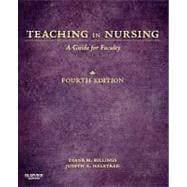Teaching in Nursing: A Guide for Faculty

Teaching in Nursing: A Guide for Faculty
- ISBN 13:
9781455705511
- ISBN 10:
1455705519
- Edition: 4th
- Format: Paperback
- Copyright: 11/14/2011
- Publisher: W B Saunders Co
- Newer Edition
Rent
From $31.60
Used From $3.33
List Price $112.00 Save
| TERM | PRICE | DUE |
|---|---|---|
Added Benefits of Renting



List Price $112.00 Save $108.67
Used
$3.33
In Stock Usually Ships in 24 Hours.
We Buy This Book Back!
Included with your book
Free Shipping On Every Order



